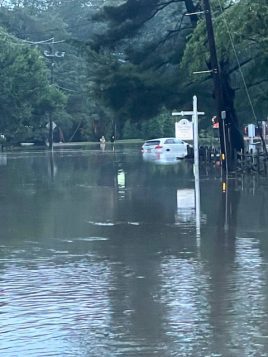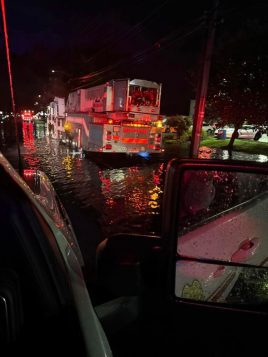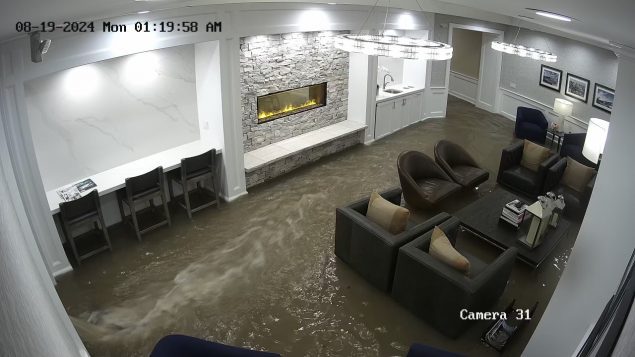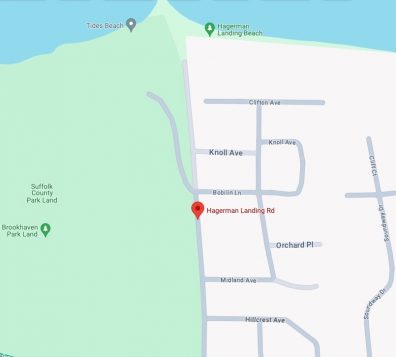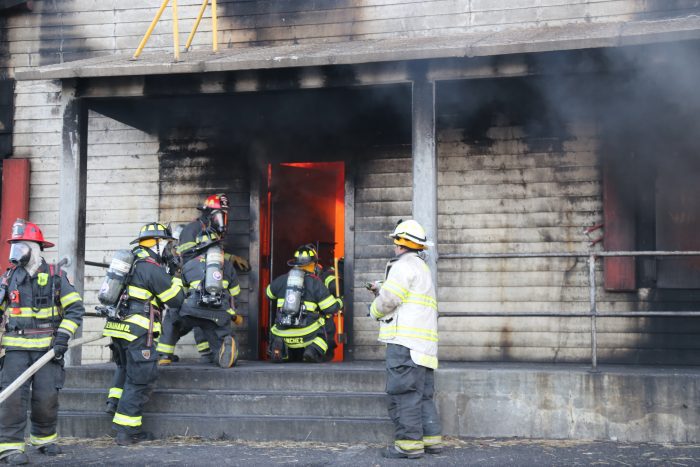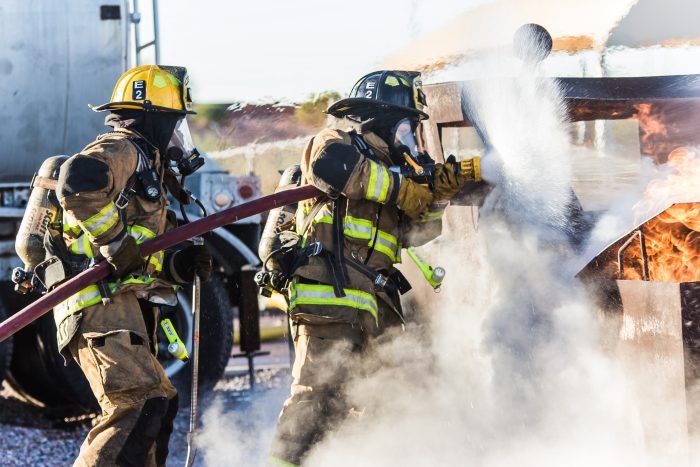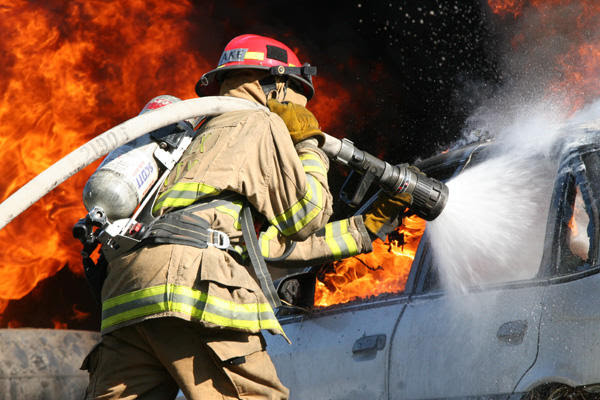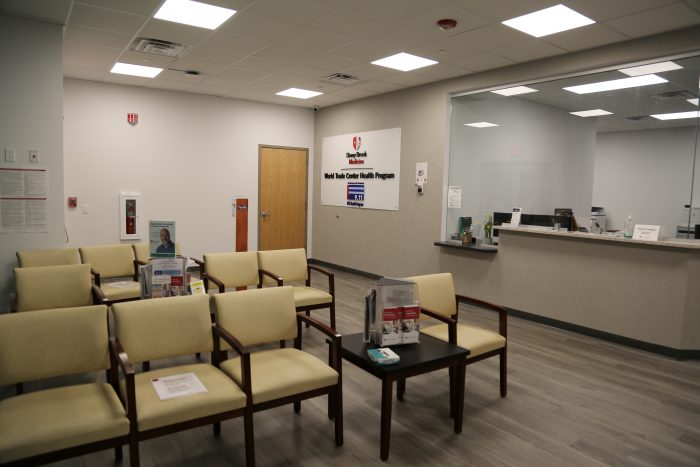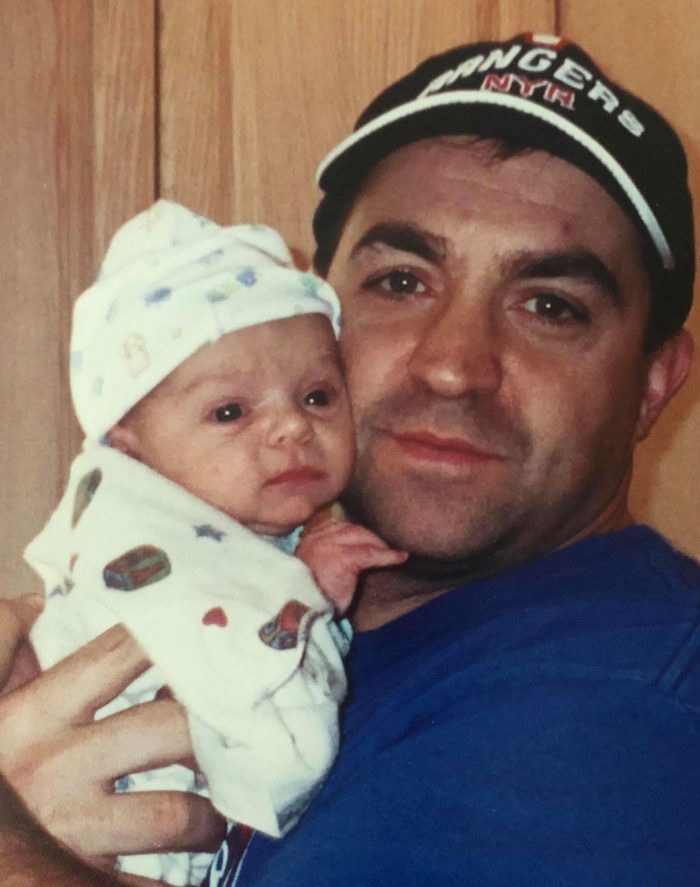Note to listeners, this episode contains graphic depictions of events on September 11th, 2001, and one offensive word.
First Responders
SBU’s Sean Clouston, Minos Kritikos show brain changes for some WTC first responders
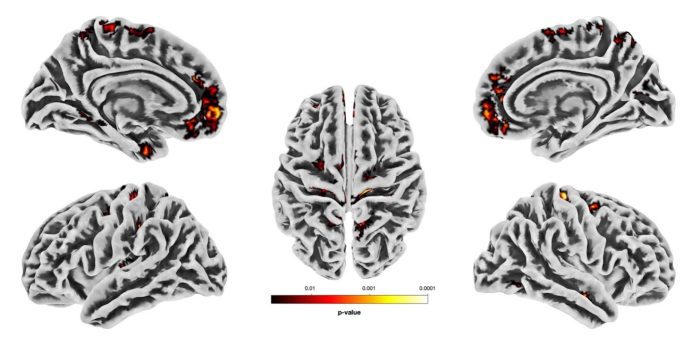
By Daniel Dunaief
Even over 23 years after first responders raced to the smoldering site of the World Trade Center terrorist attacks, many emergency crews continue to battle the effects of their exposure.
With a combination of toxic aerosolized particles infusing the air, first responders who didn’t wear personal protective equipment and who had the highest degree of exposure have suffered from a range of symptoms and conditions.
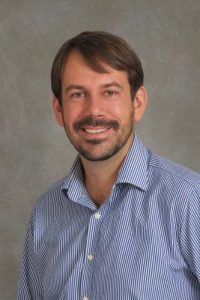
In a recent study of 35 World Trade Center first responders in the Journal of Alzheimer’s Disease, lead author Sean Clouston, who is a Professor in the Department of Family, Population and Preventive Medicine in the Renaissance School of Medicine, found evidence of amyloid plaques, which are often linked to Alzheimer’s Disease.
The paper links exposure to a neurodegenerative protein.
Research with World Trade Center first responders not only benefits those who worked tirelessly to try to find survivors and to restore the area after the attack, but also could help other people who inhale aerosolized toxins.
Indeed, such research could help those who are spending hours battling the ongoing wildfires in Los Angeles, which have been consuming forests and trees, homes and commercial buildings, at a furious and uncontrolled pace.
People have a feeling that fresh air is safe, but what scientists have learned from their studies of the World Trade Center first responders is that “just being six feet away from a pile of rubble that’s smoldering, even if you can’t see that it’s dangerous, doesn’t mean it isn’t,” said Clouston. “There is at least some risk” to human health from fires that spew smoke from burned computers and refrigerators, among others.
Given the variety of materials burned in the fires, Minos Kritikos, Senior Research Scientist and a member of the group in the collaborative labs of Clouston and Professor Benjamin Luft, suspects that a heterogeneity of particles were in the air.
People in Los Angeles who are inhaling these particles can have them “linger in their circulation for years,” said Kritikos. “It’s not just a neurological issue” as the body tries to deal with carrying around this “noxious” particulate matter. Since most neurons don’t regenerate, any toxicity induced neuronal death is irreversible, making damage to the brain permanent.
Even in non-emergency situations, people in polluted cities face increased health risks.
“There is a recognition that air pollution is a major preventable cause of Alzheimer’s Disease and related dementias, as noted by the latest Lancet Commission,” Clouston explained.
Two likely entry points
People who breathe in air containing toxic chemicals have two likely pathways through which the particulates enter the body. They can come in through the nose and, potentially, travel directly into the brain, or they can enter the lungs, circulate through the body and enter the head through the blood-brain barrier. The olfactory route is more direct, said Kritikos.
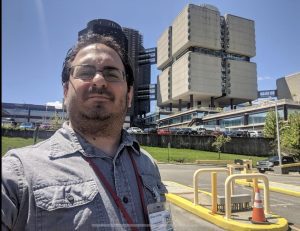
The amyloid plaques in these first responders was found primarily in the area near the nose, which supports the idea that maybe inhaling the dust was the problem, Clouston said.
Once these chemicals enter the brain, Clouston and his team believe the body engages defenses that are designed much more for viruses than for toxic compounds. The immune system can encapsulate these chemicals in amyloid plaques.
Amyloid plaques, in moderation and under conditions that protect the brain against pathogens, are a part of a protective and helpful immune response. Too much of a good thing, however, can overwhelm the brain.
“When there’s too much plaque, it can physically disturb neuronal functions and connections,” said Kritikos. “By being a big presence, they can also molecularly and chemically react with its environment.”
A large presence of amyloid can be toxically necrotic to surrounding neural tissue, Kritikos added.
What the scientists believe they are tracking is the footprint of an adaptive response that may not help the brain, Clouston added.
Clouston cautioned that the plaques and cognitive decline could both be caused by something else that scientists haven’t yet seen.
The findings
The research, which used positron emission tomography and magnetic resonance imaging scans to search for evidence of amyloid plaques, found evidence that doesn’t look like old age Alzheimer’s, explained Clouston. Usually these levels of plaques are not located in one spot, but occur throughout the brain during Alzheimer’s.
The immune response may be causing some of these plaques.
The amount of amyloid plaque doesn’t look like Alzheimer’s Disease and does not appear abnormal in the traditional way of testing, but with careful analysis of the olfactory system, the researchers can find elevated levels.
“I was surprised by how little amyloid was necessary to show this association,” said Clouston.
Researchers at Mt. Sinai have examined the effect of exposure to these same particulates in mice.
“The answer is very much similar to what we see in humans,” said Clouston. “That supports this work.”
To be sure, Clouston and Kritikos are hoping to build on this research. They are particularly interested in following up with participants to measure the rate of change in these plaques from the observed amyloid signals they measured at baseline.
“Doing so would enable us to calculate the rate of amyloid buildup allowing us to assess our responders more precisely, opening doors to possible therapeutic interventions such as the recently approved anti-amyloid therapies,” Kritikos explained.
Additionally, they hope to expand on the study beyond the 35 people who participated.
It is unclear whether tamping down the immune system could make patients better or worse. By reducing amyloid plaques, scientists might enable the harmful dust to cause damage in other areas of the brain. Alternatively, however, a lower level immune response with fewer plaques might, in the longer term, be better for the brain.
This study “does open the door for some of those questions,” Clouston said. Kritikos and Clouston plan to study the presence of tau proteins and any signs of neurodegeneration in the brains of these first responders.
“More research needs to be done,” Clouston said, which specifically targets different ways of measuring exposure, such as through a biomarker. He’s hoping such a biomarker might be found that tracks levels of exposure.
Future research could also address whether post traumatic stress disorder affects the immune response.
“It’s certainly possible that PTSD is playing a role, but we’re not sure what that might be,” said Clouston.
The researchers are continuing this research as they study the effects of exposure on tau proteins and neurodegeneration.
“We are hopeful that this will be an important turning point for us,” Clouston explained
From the Medditerranean to the Atlantic
Born and raised in Cyprus, Kritikos comes from a large family who are passionate about spending time with each other while eating good food.
He earned his doctorate from the University of Bristol in England.
Kritikos met his wife Jennifer LoPresti Kritikos, who is originally from Shirley, New York, at a coffee shop in Aberdeen, Scotland, where he was doing postdoctoral research.
LoPresti, who works at Stony Brook as the Department Head Administrator for Biomedical Engineering, and Kritikos live in Manorville and have an eight year-old daughter Gia and one-year old son Theseus.
As for his work, Kritikos is grateful for the opportunity to contribute to research with Clouston and Luft, who is the Director of the Stony Brook WTC Health and Wellness Program.
“I’m happy to be in a position whereby our large WTC team (the size of a small village) is constantly pushing forward with our understanding for how these exposures have affected” the brain health of WTC first responders, Kritikos explained. He would like to continue to uncover mechanisms that underly these phenomena, not just for WTC responders but also for similarly exposed populations.
Scenes from this weekend’s devastating storm
By Toni-Elena Gallo



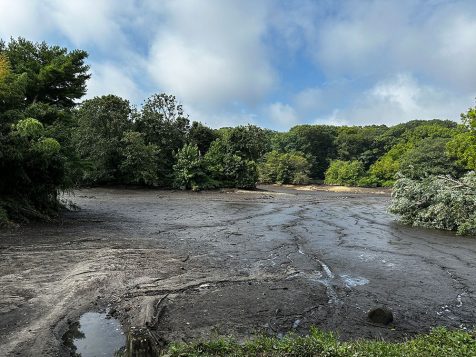



World Trade Center first responders are much more likely to develop early dementia
By Daniel Dunaief
First responders who raced to the World Trade Center site on 9/11 or who helped with the massive clean up effort did so at risk to themselves.
That was as true during those days and weeks after the attack as it is now, with many of the first responders experiencing a range of diseases and conditions linked to the difficult work they did in 2001.
In a study released recently in the journal JAMA Network Open, Sean Clouston, Professor in the Program in Public Health and in the Department of Family, Population and Preventive Medicine in the Renaissance School of Medicine at Stony Brook University, showed that 4.6 percent of the responders in a study developed dementia. That compares with 0.5 percent for the general population of people who would develop cognitive declines in a similar age group.
Between November of 2014 and January of 2023, 228 responders without dementia and under 60 years old at the start of the study developed dementia over the next five years.
“It’s stunning to see these kinds of symptoms in such young people,” said Clouston.
Through the Stony Brook WTC Health and Wellness Program, Clouston and other researchers have documented some of the cognitive declines in this population, who likely inhaled the kinds of fine particulate matter that can enter the brain and cause damage even as the immune system fights to try to target the unwelcome contaminants.
“We assume this made it in the brain, but in such a way that it wasn’t overwhelming immediately,” said Clouston. “Once you get into a neurodegenerative space, most of these diseases take a long time to develop” with neurodegenerative processes sometimes taking decades to occur.
The exposure could have caused an immune reaction. They are not sure whether symptoms emerged because the reaction was stronger or if the symptoms developed because higher exposure triggered a stronger reaction.
“It’s like trying to fight a fire, and the truck rolls over a garden to do it,” said Clouston.
Fortunately, the brain has considerable redundancy, which makes it possible to reroute brain signals to compensate for problems. Over time, however, that ability might be damaged by that work or by the exposure.
Determining which particular chemical or chemicals causes the greatest damage is difficult, particularly because the collapse and burning of the buildings caused a heterogeneous mixture of so many industrial products to enter the air. It may not matter much, as any material in the brain could be a problem. The type of exposure may also affect the severity of the immune reaction or which parts of the brain are damaged.
Scientists suggest that some of the contaminants that have contributed to health defects may come from the various tools in offices, such as computers and air conditioners.
“As we go forward [with other studies], that will be a focus of ours, to see if we can’t isolate at least one or maybe a couple” of chemicals that could exacerbate the cognitive decline, Clouston said.
Different exposures
Clouston and his collaborators used surveys to find out exposure at the site.
Some of the first responders, for example, used face masks and wore personal protective equipment, including hazmat suits. The incidence of dementia among that group was considerably lower than it was for those who didn’t wear masks.
Five or six out of every 1,000 workers who wore PPE developed dementia, while those without protection developed cognitive decline at the much higher rate of 42 out of 1,000.
The researchers tried to address the possibility that those people who were masks lived a healthier lifestyle prior to 9/11 and may have already been less likely to develop diseases or health conditions.
“We tried to account for that,” Clouston said. In most cases, people aren’t avoiding the kinds of activities or decisions that likely contribute to dementia, such as diet and exercise, which, the general population “widely ignores already,” he said.
Additionally, while a family history of dementia or other medical conditions mattered to some degree for the reported cases, they weren’t sufficient to invalidate the statistically significant result.
To be sure, Clouston acknowledged that the study could have a screening bias, as cognitive evaluations every 18 months likely far exceeds how often most people in the same age group receive testing for their mental acuity.
This is one reason they developed a minimally exposed group that could account for that bias. In that group, dementia was close to, but still higher than the expected rates for the general population.
The number of first responders with dementia far exceeded this group.
Other health threats
Medical professionals have been studying the impacts of other events that release aerosolized particles that could be hazardous to people’s health and could damage the environment.
Burn pits, which the military used in Iraq and Afghanistan, among other locations, contributed to cancers and other diseases among members of the military serving overseas.
Natural disasters, such as the Maui fire last August that not only burned through forests but also destroyed commercial buildings, also create a hazard.
People fled the fire quickly and then returned to search for their loved ones, Clouston said, which exposed them to aerosolized dust.
It would be “good to think about studies to consider risk of dementia” from these events, he added.
“These studies would probably take a while to complete as the risk grows with time and with age.”
Perspective: Be a neighbor helping neighbor through your local fire or ambulance department
By Ed Romaine
Suffolk County has 109 volunteer fire departments and 28 EMS agencies with more than 13,000 active men and women firefighters and EMS personnel. Each year they respond to thousands of calls, never knowing what they will face as they leave their homes — saving countless lives and protecting homes and businesses in our communities.
But these departments need help. Suffolk County is currently part of an aggressive recruitment and retention drive for new volunteer firefighters and EMS personnel. It is easy to take for granted that someone will swiftly come when you dial 911. Over the past two decades, our region’s recruitment has fallen behind, leaving those that remain burdened with extra responsibilities to shoulder.
The government has been working to provide more incentives to those who are interested in becoming a part of their local fire or ambulance department.
Despite what may appear as a difficult endeavor, it has never been a better time to be a volunteer firefighter or EMS personnel. Through a combination of local, state and county programs, volunteers receive property tax reduction, New York State income tax benefits, free health care checkups, free insurance, college tuition reimbursement and service pensions as well as free equipment and training.
Recently, the state income tax benefit was expanded, and the service pension was enhanced for EMTs. With rising medical costs, the value of health care and routine checkups has only increased. We will continue to work with state and local governments to expand these benefits wherever possible.
Firefighters are the heart of our communities. Whether it is in the scope of their official duties or through the many ways they charitably enhance our communities, the fire department is never out of the beat with the community.
Volunteers point to the camaraderie, lifelong friendships and professional development as reasons for joining and staying.
It has never been easier to join your local fire department. A visit to the website suffolksbravest.com will provide all the information you need to start your journey. If you have a passion for serving your community and are willing and able, now is the time to heed the call.
Ed Romaine (R) is the Suffolk County executive.
Port Jeff civic hosts local fire department and EMS organizations
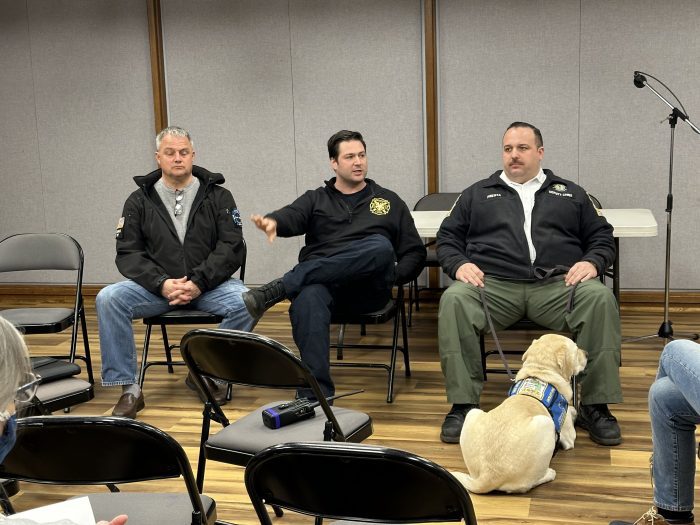
By Samantha Rutt
The Port Jefferson Civic Association hosted a meeting on Feb. 12 dedicated to first responders.
“Our first responders have been there for us many a time, we have invited them here to help our residents learn what it takes to run such operations as well as learn what unique challenges they face,” civic association President Ana Hozyainova said.
The Port Jefferson Fire Department and EMS organizations have long been pillars of the Port Jefferson community, providing crucial emergency services to residents in times of need. However, recent challenges have highlighted the strain on these vital institutions, ranging from outdated facilities to a shortage of funding and volunteers.
One of the primary issues facing the Port Jefferson Fire Department and EMS is the state of their facilities. Many of the buildings housing these organizations are small and outdated, failing to meet the needs of modern emergency response. These facilities lack adequate space for equipment storage, training facilities and administrative offices, hindering the effectiveness of operations.
The most prominent issue facing the fire department is flooding. The location of the historic building is nestled in one of the lowest points of the town’s landscape allowing it to be highly susceptible to excess water. Third assistant fire chief, Christian Neubert, explained past complications the department faced during severe storms and excess rain.
“One of the big problems we have is the firehouse floods,” Neubert said. “So, getting the firefighters to the fire department can be complicated. We have a flood protocol that we put in place after the 2019 flood, that when there is an alarm, certain apparatuses are allocated to certain sides of Maple Place. Some go up the hill and some go down toward the village.”
The issue of flooding exacerbates the challenges already faced. Flooding not only poses a threat to the safety of personnel but also endangers critical equipment and resources essential for emergency response efforts.
“That’s one of our starting points for mitigating those emergencies,” Neubert added. “There’s a lot of logistical complications when we deal with those types of floods.”
Like the fire department, the EMS organization is also experiencing a facility crisis. The organization runs an EMS training program with Stony Brook University students.
“We run an EMS training program, the EMS Academy, out of our facility,” Mike Presta, deputy director from Port Jefferson EMS explained. “We make our pre-health student EMTs and they go on to serve the community for the four or five or six years that they’re working toward becoming a health professional.”
Presta continued explaining the program in greater detail, “Almost five years ago, we actually developed a program where they live in the building. We have 15 college kids that live there, they get free room and board.”
Though the efforts and intention of the EMS organization are pure, they face challenges running their organization alongside the student training program. Presta explained that due to the need for living quarters, the organization has set up trailers in the rear of the property to best suit the other operations of the organization.
In addition to facility woes, the Port Jefferson Fire Department and EMS are grappling with a significant shortage of volunteers. Traditionally volunteer-based, these organizations rely on community members willing to dedicate their time and expertise to serve their neighbors. However, in recent years, recruitment efforts have struggled to attract new volunteers.
“We don’t get a lot of local community volunteers. We don’t really have many from the village, we don’t have any from Belle Terre, we don’t have any from Mount Sinai. So, our organization has grown to really rely on our Stony Brook University students,” Presta said.
Funding is also an issue facing these organizations as they rely heavily on property tax levies within the district and little elsewhere.
“Unlike some of our neighboring districts and partners, we don’t have as large a commercial tax base means that we don’t get to pull from a Walmart or a BJ’s or Target or Home Depot or a Lowe’s, we don’t have those large places,” Neubert said. “So, we have to be very mindful with our spending.”
Neubert continued explaining some of the ways the department has made efforts to save: “Recently, the fire district outsourced this faction of services to the supported firemen. So, our dispatchers now are Setauket dispatchers. That was a huge savings for the fire district, because they no longer had to pay full-time dispatchers out of the firehouse. And the reason that had happened was because insurance premiums have gone significantly up because of the recent floods.”
In the face of these challenges, the dedication and commitment of the members of the Port Jefferson Fire Department and EMS remain unwavering. Despite the obstacles they face, these individuals continue to serve our community, ensuring the safety and well-being of all residents. As a community, it is incumbent upon us to support and strengthen these essential organizations as they work tirelessly to keep Port Jefferson safe.
The meeting also served as the first opportunity to register interest in running for officer positions for the civic association. Offices open for elections are, president, vice president, treasurer, recording secretary and corresponding secretary. Only members in good standing are eligible to run and the deadline to submit interest is March 11, also the date of the next association meeting.
Suffolk County Firefighters and EMS recruitment event to be held July 16
Suffolk County Executive Steve Bellone has announced the Suffolk County Department of Fire, Rescue and Emergency Services (FRES) and the Suffolk County Fire Academy will jointly host a Firefighters and EMS Recruitment Event on Saturday, July 16 from 8 a.m. to 1 p.m. at the Suffolk County Fire Academy located at 102 East Avenue in Yaphank.
The five-hour event will feature various vehicle demonstrations and on-site resources for potential future firefighters and emergency medical service members to become familiar with, including a live exercise that will simulate a train-vehicle incident and response. The Long Island Railroad, Brookhaven Fire Department and South County Ambulance will be participating in the demonstration.
Recruitment specialists from Suffolk County will be available to discuss the many benefits available to potential first responders. Representatives from the Air National Guard’s 106th Rescue Wing based in Westhampton Beach will also be in attendance for recruitment purposes.
“In Suffolk County, we are committed to ensuring that our volunteer fire and EMS agencies have the necessary resources to operate and protect our residents. A key component of this includes recruitment. That is why our Department of Fire, Rescue and Emergency Services continues to engage with our departments and communities to provide these important events,” said Suffolk County Executive Steve Bellone. “Last year’s inaugural event was a success as more than 125 residents signed up to become a first responder in their local community, and we look forward to achieving the same success this summer.”
“Recruitment and retention events continue to be essential for fire and EMS agencies as we need to continue to engage with our residents and educate those who are interested in becoming a first responder of all the tremendous benefits our local departments and volunteer organizations can provide,” said Suffolk County FRES Commissioner Patrick Beckley. “This summer’s open house will both be interactive and educational, and we encourage residents of all ages to attend.”
The event will also encompass a food drive component as Island Harvest will be on-site to accept non-perishable goods, including canned vegetables, sauces and soups, pasta, beans, rice, personal care and toiletry items and feminine hygiene products. Fire departments and attendees are all encouraged to participate and donate.
This summer’s open house event follows FRES’ first recruitment event in October 2021 where more than 125 prospective firefighters and EMS personnel signed up to become volunteer members with their local departments and agencies. The open house is part of Suffolk County’s comprehensive approach to first responder recruitment, including the Vets to Vollies Program that launched in April 2022.
Candidates who are interested in becoming a first responder, but are not able to attend the recruitment event can go to suffolksbravest.com/volunteernow. All junior firefighters and educational groups are also invited to attend.
The Suffolk County Department of Fire, Rescue and Emergency Services (FRES) is committed to serving both the 1.5 million residents of Suffolk County and the more than 11,000 emergency responders who are dedicated to saving lives and protecting property.
Vanderbilt Museum to offer First Responders and their families free admission this weekend
Sponsored by Northwell Health
In honor of National First Responders Day, the Suffolk County Vanderbilt Museum, 180 Little Neck Road, Centerport will thank First Responders and their families by offering them free general admission on Saturday and Sunday, October 30 and 31, from noon to 5 p.m. First responders will be asked for ID cards or proof of affiliation.
The Vanderbilt also will offer them discounted tickets for the Museum’s Fall Festival: $13 for kids and $14 for adults.
“We salute the brave men and women who make sacrifices and face danger every day to protect our communities,” said Elizabeth Wayland-Morgan, executive director of the Vanderbilt. (This includes police and firefighters, emergency medical personnel.)
“We’re offering free admission because these people are our neighbors and they provide essential services,” Wayland-Morgan said. “It’s hard on their spouses, families, and children. A fun day at the Vanderbilt is one way to thank them.”
For more information, call 631-854-5579 or visit www.vanderbiltmuseum.org.
Twenty years after 9/11 Stony Brook doctor continues to help first responders
Dr. Benjamin Luft remembers the feeling of being prepared to treat 9/11 survivors and then no one arrived at the hospital.
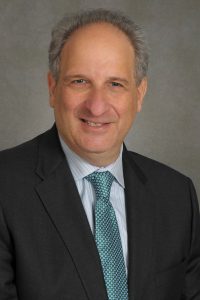
Stony Brook University was among local medical facilities that were prepared for the arrival of 9/11 victims when Luft was the chairman of the Department of Medicine. He said, like others, he had seen the towers falling on television, and from the 16th floor of SBU’s Health Sciences Tower, he could see the smoke from the World Trade Center.
“The idea was that there was going to be real mass casualties, and that this would overwhelm the system in New York,” he said.
Medical teams from various departments met in the conference room of the Department of Medicine, but he said “it became obvious as time went on, that there was no one coming to Stony Brook.”
“It was eerily ominous, because we began to understand that either people had escaped the buildings, or … that there were relatively few survivors from the attack itself,” the doctor added.
He said anyone seeking treatment stayed in the city, and the hospitals in Manhattan weren’t overrun as originally anticipated.
Luft, who is now the director and principal investigator at Stony Brook WTC Wellness Program, said after the tragic day he visited Ground Zero to see what was happening at the site. It was there he witnessed what first responders were being exposed to while working.
“It was obvious that there was going to be a lot of responders that were going to become ill as a result of that, because there was a tremendous amount of dusts and toxins in the air,” Luft said. “There was a lot of fire, burning, and there was a lot of fumes that came off of burning plastic and electronics.”
He added there were traumatizing events that people at the site experienced such as seeing bloody human parts and, for earlier responders, people jumping out of the towers.
He said shortly after September 11, local labor leaders met with him and told him how many of those first responders lived on Long Island and were getting sick. He learned that while many were insured, their insurance wasn’t covering their health issues due to them volunteering and not doing what the insurance companies considered on-the-clock work while helping to clean up and recover victims at Ground Zero.
The struggle of the Long Island first responders led to the development of the Stony Brook WTC Wellness program. In 2002, patients at first were just screened and monitored and then in 2005 doctors began treating them. Luft said in the early days of the program SBU Department of Medicine employees would volunteer to treat the patients. Over time the program began to receive financial resources to expand its services.

Luft said the program follows the cases of approximately 13,000 Long Islanders in both Nassau and Suffolk counties, with one clinic in Commack and the other in Mineola. At first, patients were displaying acute reactions to their exposure. Cases included asthma, upper respiratory disease, sinusitis and gastrointestinal disease, he said, due to the amounts of dust the patients had taken in during their time at Ground Zero.
Over the years, the doctor said patients began developing illnesses such as cancer, but doctors have also seen psychiatric problems such as PTSD and depression.
The responders “had seen people die,” he said. “They were in danger all the time.”
Doctors are also seeing cases of dementia in patients. Luft said one theory is that when a person is exposed to certain toxins it can increase their chances of having dementia. He gave the example where areas with higher pollution have much higher rates of Alzheimer’s.
With studies showing that patients with PTSD have cells that age more quickly, the WTC Wellness Program began monitoring patients.
“We saw something that stunned us, and quite frankly at first we were very skeptical,” Luft said. “We went through a variety of different studies and tests to confirm our results.”
Twenty years after September 11, the doctor said it’s possible that first responders will present with more health issues in the future, but no one can be certain with what illnesses.
The Stony Brook WTC Wellness Program’s Suffolk County office is located at 500 Commack Road, Commack.
A son honors his first responder dad’s legacy
He was only 3 years old when his father passed away.
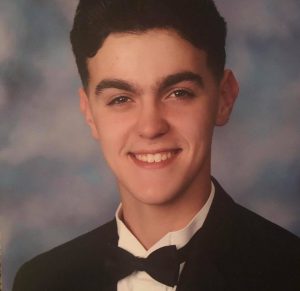
Matthew Brophy, of Smithtown, is now 19 years old and has no personal memories of his father Thomas Brophy. His dad was a New York City police officer for 16 years and was also a first responder at Ground Zero. His father died in 2005 at the age of 36 after a battle with metastatic colon cancer. Doctors believed Tom Brophy’s cancer stemmed from his work at Ground Zero during the days after September 11.
Matthew Brophy, now a sophomore at Adelphi University, has the memories that his mother Rita and loved ones have shared with him through the years. The stories have left him with a loving impression of his father.
“I would describe him as a valiant, strong and charismatic individual,” Matthew Brophy said.
Among those in his life who knew his dad are old friends, including Tom Brophy’s police partner Rich Seagriff and training buddy Matt Fagan.
“His old friends treat me like I am their own son,” he said.
The son said one of his favorite stories is hearing how his father lost sight of him for a brief moment at Best Buy when he was 2. The then-toddler had a SpongeBob DVD in his hand and started walking out of the store only to set off the alarm.
Like his parents, Brophy grew up in the Hauppauge school district. He graduated from Hauppauge High School in 2020. When it came time to learn about 9/11 in class, he said the information was nothing new to him.
“I really haven’t learned anything particularly new in the school system about 9/11 and Ground Zero due to me being a child that was involved with it,” he said. “If anything, I knew more than the teachers about it. For the most part, it is taught just to be taught in history in the first week because the first or second week of high school in America usually falls on 9/11, at least in Suffolk it does.”
Brophy added it’s not a subject teachers delve into that deeply and usually students are shown a video of the planes crashing into the towers.
“It gets to a point where it’s so routine I genuinely feel offended, especially when everyone in the class knows that they’re in a class with a kid whose dad died from 9/11,” he said. “Needless to say, I don’t think it’s something that needs to be taught as of now, but in the future, yes. If people are still suffering physically from an event, that means that it is still undeniably relevant enough to be known.”
Brophy was recently awarded a scholarship from the First Responders Children’s Foundation and is currently pursuing a degree in psychology. He also has been juggling three jobs.
His mother said she is proud of him and “the man he is becoming.”
Rita Brophy said her son’s biggest quality is loyalty, just like his dad.
“He is exposed to many friends with many cultural beliefs and he respects them,” she said. “Hopefully, his view in the world will continue to be open-minded and loving of everyone he meets.”




